Ultimate Guide to Kling API: Transform Images & Text into Stunning Videos (2025)
The Kling API represents a breakthrough in AI-powered video generation, allowing developers to transform static images and text prompts into dynamic, high-quality videos with remarkable ease. Developed by Kuaishou, one of the world’s largest video-based social networks with over 400 million users, Kling has quickly established itself as a leading competitor in the AI video generation market.
In this comprehensive guide, we’ll explore everything developers need to know about integrating and leveraging the Kling API in 2025, from core capabilities and pricing models to practical implementation strategies and real-world applications.

What is Kling API?
Kling API provides programmatic access to Kuaishou’s state-of-the-art video generation AI models. The API enables three primary transformation capabilities:
- Text-to-Video Generation: Create videos directly from detailed text prompts
- Image-to-Video Generation: Animate static images based on text guidance
- Video Continuation: Extend existing videos with AI-generated content
- Virtual Try-On: Visualize clothing items on models using AI
What sets Kling apart is its exceptional ability to simulate realistic physics, create cinematic camera movements, and generate high-resolution outputs (up to 1080p) while maintaining contextual consistency throughout the video.
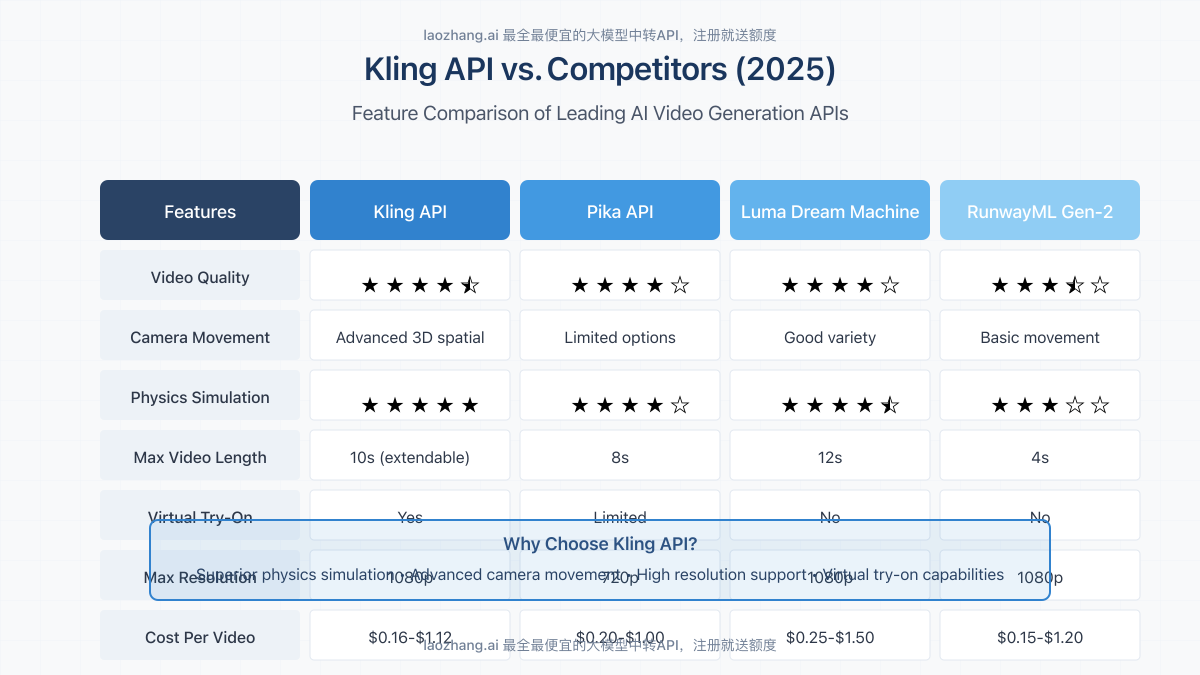
Key Features and Capabilities
1. Professional Camera Movement
Kling leverages 3D spatio-temporal attention modules to enable various camera movements, including pan, zoom, rotate, and track. This creates immersive and engaging video content with complex cinematic relationships between objects.
2. Accurate Physics Simulation
Through Kuaishou’s proprietary model architecture and extensive training datasets, Kling can accurately simulate real-world physics, producing videos that align with realistic physical constraints and natural movement patterns.
3. Multiple Video Extensions
The API supports video continuation, allowing developers to extend original videos with additional content. Each extension adds approximately 4.5 seconds of new footage while maintaining visual and contextual consistency with the source material.
4. Adjustable Aspect Ratios
Kling API supports various aspect ratios to meet different video usage scenarios, making it versatile for content creation across platforms, from social media to entertainment applications.
5. Virtual Try-On
The API includes virtual try-on capabilities powered by Kling’s image generation technology. Developers can upload garment images and model photos to create realistic visualizations of clothing items on different people.
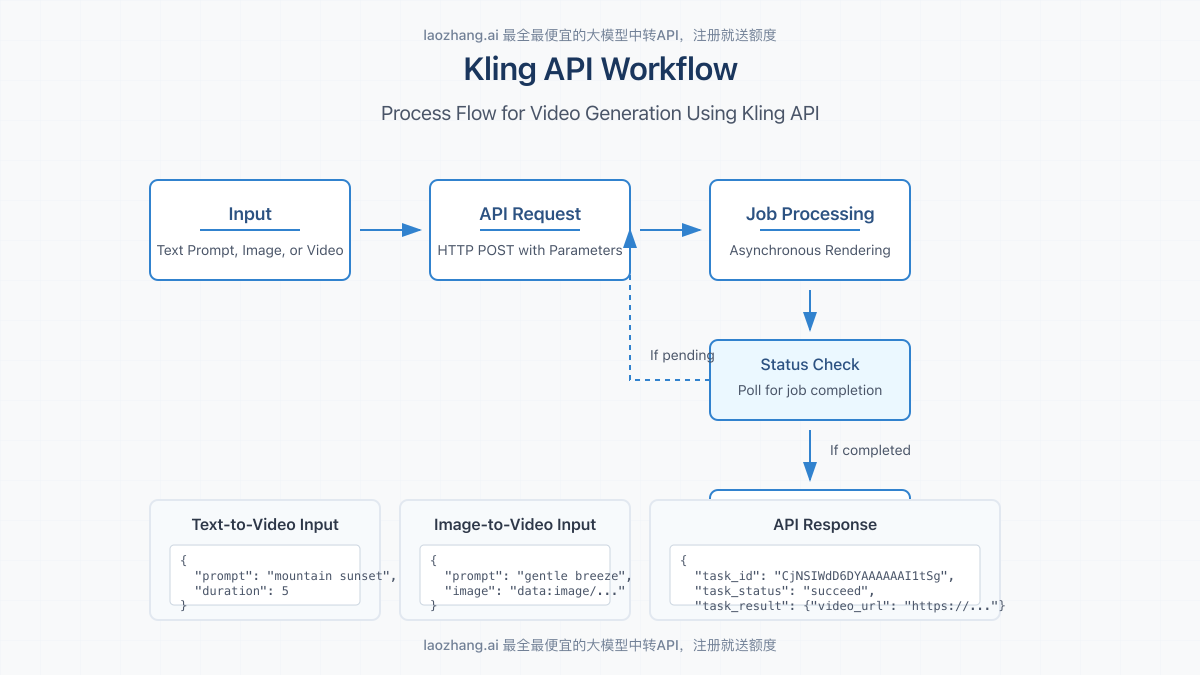
API Integration Guide
Authentication and Setup
To access the Kling API, you’ll need to obtain an API key from one of several providers that offer access to the service. Currently, Kuaishou does not provide direct API access, so third-party API providers like PiAPI, Appy Pie API, and others offer access through their platforms.
Basic authentication typically involves including your API key in the request headers:
// Example API Authentication
const headers = {
'Content-Type': 'application/json',
'Authorization': 'Bearer YOUR_API_KEY',
'Cache-Control': 'no-cache'
};
Making API Requests
The Kling API typically follows an asynchronous pattern where you submit a job and then query for results:
// Example Text-to-Video Request
const requestBody = {
"prompt": "A majestic eagle soaring over mountains at sunset, cinematic 4k",
"negative_prompt": "blurry, low quality, distorted",
"num_inference_steps": 30,
"guidance_scale": 7.5
};
// POST request to initiate video generation
fetch('https://api.provider.com/kling/text-to-video', {
method: 'POST',
headers: headers,
body: JSON.stringify(requestBody)
})
.then(response => response.json())
.then(data => {
const taskId = data.task_id;
// Store task ID for checking generation status
})
.catch(error => console.error('Error:', error));
Handling Responses
Since video generation is computationally intensive, the API operates asynchronously. After submitting a generation request, you’ll receive a task ID that you can use to check the status of your video:
// Example Status Check Request
fetch(`https://api.provider.com/kling/status?task_id=${taskId}`, {
method: 'GET',
headers: headers
})
.then(response => response.json())
.then(data => {
if (data.status === 'completed') {
const videoUrl = data.result.video_url;
// Process the completed video
} else {
// Handle pending or failed status
}
})
.catch(error => console.error('Error:', error));
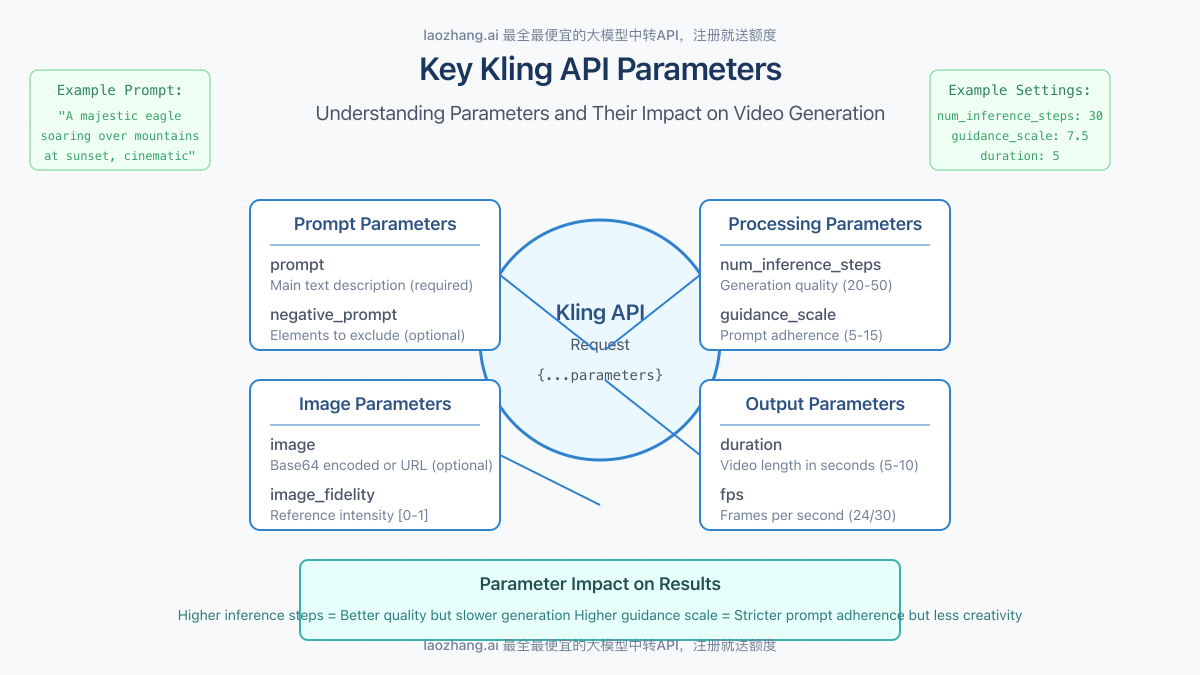
Pricing Models and Options
Kling API access is typically available through two main pricing models:
1. Pay-as-you-go Model
This pricing structure charges per video generation, with costs varying based on several factors:
- Video Length: Standard 5-second videos ($0.16-$0.56) vs. 10-second videos ($0.32-$1.12)
- Processing Mode: Standard mode or Professional mode (with enhanced quality)
- Resolution: Higher resolutions may incur additional costs
- API Provider: Different providers may offer varying rates and package deals
2. Host-your-account Model
Some providers like PiAPI offer a “host-your-account” option at around $10/seat/month, which allows you to:
- Connect your own Kling accounts
- Access all API features
- Support for hosting multiple accounts
- Load balancing for multi-account setups
This model is particularly cost-effective for developers with high-volume needs who already have Kling accounts.
5 Practical Applications of Kling API
1. E-commerce Product Visualization
Transform static product images into engaging videos that showcase items from multiple angles, demonstrating features and functionality. The virtual try-on capability is particularly valuable for clothing retailers, allowing customers to visualize garments on models.
2. Digital Marketing and Advertising
Create dynamic video advertisements from existing brand assets and promotional images. Marketers can quickly generate multiple video variations for A/B testing without expensive production costs.
3. Educational Content
Convert diagrams, charts, and illustrations into animated educational videos that explain complex concepts. This is especially useful for online learning platforms and educational publishers.
4. Social Media Content Creation
Develop engaging short-form video content for platforms like TikTok, Instagram Reels, and YouTube Shorts. Content creators can transform their static graphics into attention-grabbing videos optimized for each platform’s aspect ratio.
5. Video Game and Animation Development
Generate concept animations and previsualization sequences for game development and animation projects. This accelerates the creative process and allows for rapid iteration on visual concepts.
Performance Considerations and Limitations
While Kling API offers impressive capabilities, developers should be aware of certain limitations:
Resolution Constraints
Although Kling can generate videos up to 1080p resolution, the actual output quality may vary. As Kuaishou’s infrastructure continues to improve, resolution limitations will likely be addressed with more computing power.
Processing Time
Video generation is computationally intensive, often requiring 30-90 seconds per generation depending on video length, complexity, and current server load.
Content Restrictions
Like most AI generation tools, Kling has content policies that prohibit certain types of outputs, including explicit content, copyrighted material, and potentially harmful imagery.
Watermarking
Generated videos typically include the Kling watermark. While some users attempt to remove this with third-party tools, doing so may violate terms of service and potentially create copyright issues.
Comparison with Alternatives
Kling competes in an increasingly crowded field of AI video generation tools:
| Feature | Kling API | Pika API | Luma Dream Machine | Runway Gen-2 |
|---|---|---|---|---|
| Camera Movement | Advanced 3D spatial attention | Limited movement options | Good movement variety | Basic movement options |
| Physics Simulation | Excellent | Good | Very Good | Moderate |
| Video Length | Up to 10 seconds (extendable) | Up to 8 seconds | Up to 12 seconds | Up to 4 seconds |
| Resolution | Up to 1080p | Up to 720p | Up to 1080p | Up to 1080p |
| Pricing (approx.) | $0.16-$1.12 per video | $0.20-$1.00 per video | $0.25-$1.50 per video | $0.15-$1.20 per video |
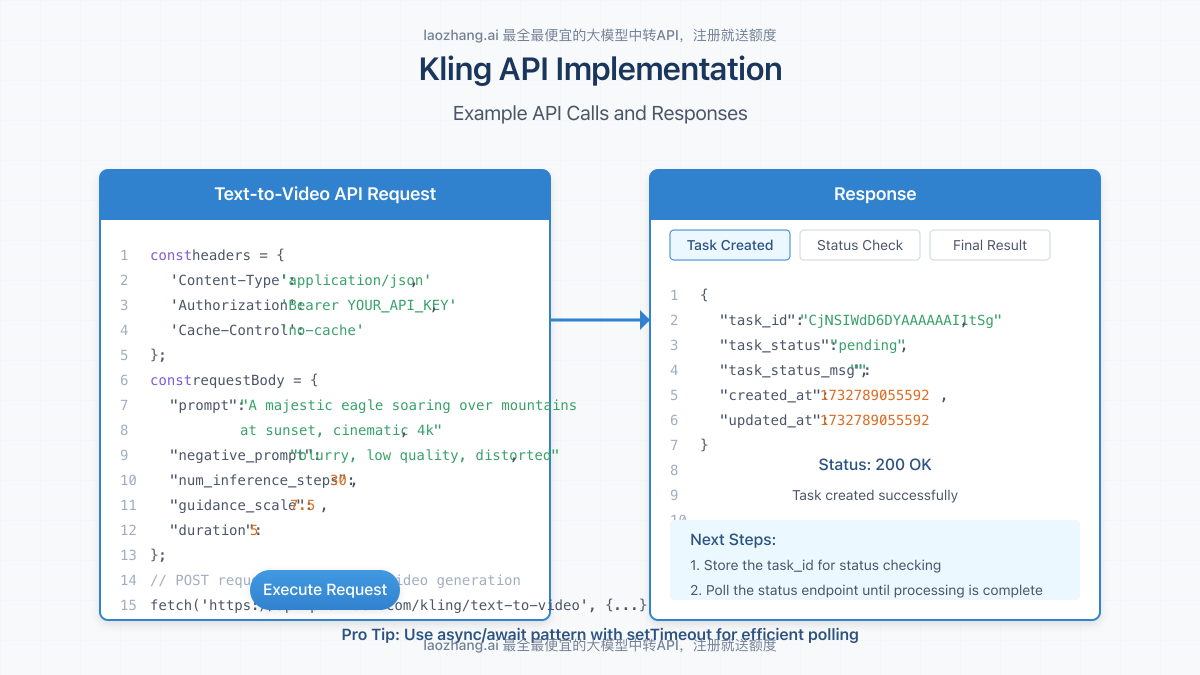
Optimizing Your Kling API Integration with laozhang.ai
For developers looking to integrate Kling API into their applications efficiently and cost-effectively, laozhang.ai offers a compelling solution. As a comprehensive API forwarding service, laozhang.ai provides access to Kling API and many other AI models with significant advantages:
- Cost Savings: Enjoy discounted rates compared to direct API access
- Simplified Integration: Single unified API for accessing multiple AI models
- Free Credits: New users receive free credit upon registration
- Robust Documentation: Comprehensive guides for quick implementation
Beyond Kling, laozhang.ai provides access to Claude and ChatGPT APIs, making it a versatile platform for developers working with multiple AI technologies.
To get started with laozhang.ai, register at https://api.laozhang.ai/register/?aff_code=JnIT and explore their comprehensive documentation.
Here’s an example of how to use laozhang.ai to access Kling API:
curl https://api.laozhang.ai/v1/kling/generate-video \
-H "Content-Type: application/json" \
-H "Authorization: Bearer $API_KEY" \
-d '{
"prompt": "A beautiful mountain landscape with flowing rivers and clouds, cinematic camera movement",
"negative_prompt": "low quality, blurry, distortion",
"source_type": "text",
"output_format": "mp4",
"duration": 5
}'
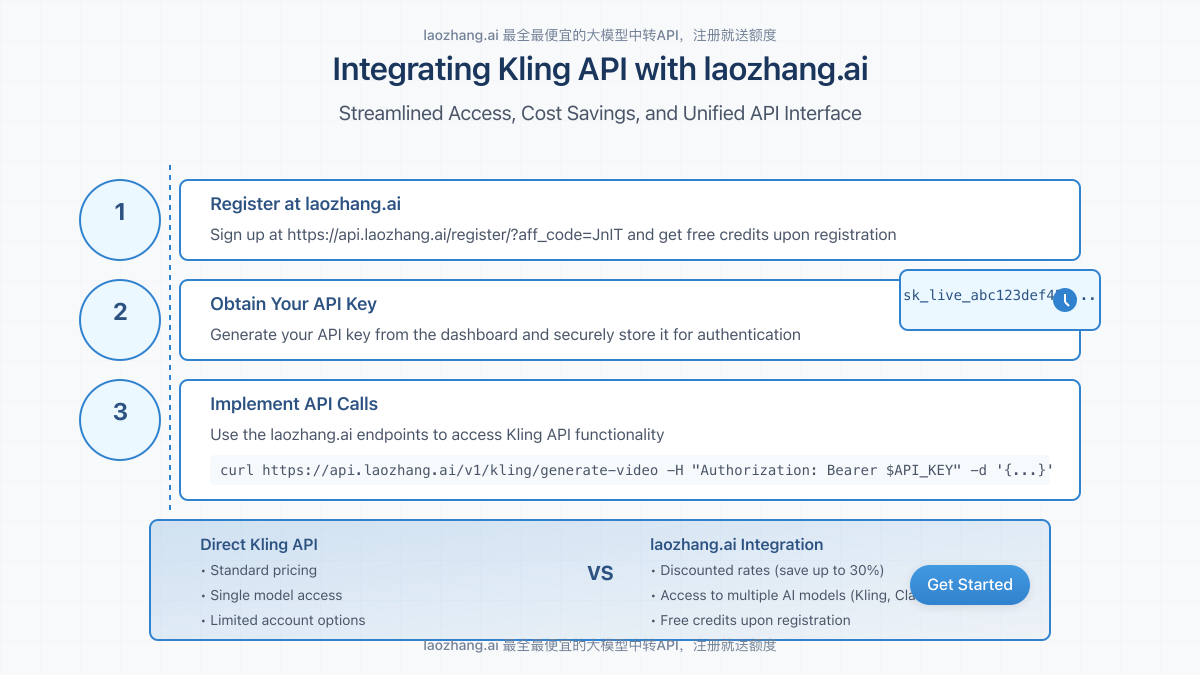
Conclusion: The Future of Kling API
As AI video generation continues to evolve rapidly, Kling API represents one of the most impressive offerings available to developers in 2025. Its combination of realistic physics simulation, professional camera movements, and high-resolution output makes it suitable for a wide range of applications across industries.
While the technology still has some limitations—particularly around resolution consistency and processing time—these are expected to improve as Kuaishou continues to enhance the underlying model and infrastructure.
For developers looking to integrate video generation capabilities into their applications, Kling API offers a powerful and cost-effective solution that can transform static assets into engaging dynamic content with minimal effort. Whether you’re building an e-commerce platform, content creation tool, or educational application, Kling API provides the capabilities needed to create professional-quality videos programmatically.
By leveraging a service like laozhang.ai for API access, developers can further optimize their implementation, reducing costs and simplifying integration while gaining access to multiple AI models through a unified interface.
Frequently Asked Questions
Can I use Kling-generated videos for commercial purposes?
While Kling API enables commercial use of generated videos, it’s advisable to check Kuaishou’s specific terms. Generated videos typically include watermarks, and their removal might violate terms of service.
How does Kling API compare to OpenAI’s Sora?
While Sora has demonstrated impressive capabilities in research previews, Kling offers practical advantages for developers today, including wider availability, established pricing models, and proven reliability at scale.
What programming languages can I use with Kling API?
Kling API is language-agnostic, working with any programming language that supports HTTP requests, including JavaScript, Python, Ruby, PHP, Java, and others.
Does Kling API support batch processing?
Yes, many Kling API providers offer batch processing capabilities, allowing developers to submit multiple generation jobs simultaneously for more efficient content creation at scale.
How can I improve the quality of generated videos?
For best results, use detailed, specific prompts, include style references, specify camera movements explicitly, use the Professional processing mode when available, and consider post-processing for final touches.